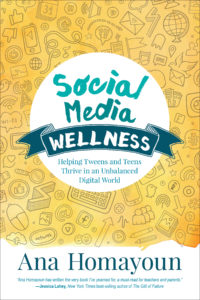1. Check your kid’s phone. “Particularly in middle school but also in high school, kids should know that parents can ask for their phones at any point and be allowed full access,” Ana says. While some parents take a more hands-off approach because, they say, they want to respect their kids’ privacy, it’s important to make the distinction between privacy and safety. “Twenty-four-hour access doesn’t mean 24-hour snooping. It means that a parent is still responsible for monitoring what a minor does online.”
2. Be app-savvy. “If your kid is on it, you should be, too,” Ana says of apps and social media platforms. “You don’t have to have an account, but at least try it out so you can have informed conversations about it. If your kids know that you understand the social media they’re using, they’re more likely to come to you to talk about issues that pop up.”
3. Help kids understand their “why.” Inspire kids to act out of internal motivation instead of fear, Ana says, by helping them build their own filter. “Encourage your kids to ask themselves ‘Why am I picking up my phone? Am I bored, am I lonely, am I sad? Am I just uncomfortable because I’m in a room where I don’t know anyone?’ Asking themselves “why” also slows down impulsive online communications, and encourages kids to make smarter choices.
4. Set clear ground rules. Talk to your kids about appropriate social media use before you give them a phone or allow them to download a new app. “Once you hand it over, they’ll be too excited to focus on your instructions.” Clearly state rules and expectations, and stick with them as much as possible. Ana also encourages parents to involve kids in creating a family mission statement about responsible technology usage.
5. Create opportunities for digital detox. “Give kids a budget to plan their own screen-free adventures — don’t just say, ‘Okay, kids, get offline and come do some chores,’” Ana says. She also points out that kids need to learn how to be okay with being offline. Parents can start by modeling that behavior: No phones at the dinner table, for example, or no checking texts while you’re talking with your kid. And while most kids won’t admit it to their parents, an enforced break from technology could be just what they need.
 frequently at our Green Ivy offices. While we’ve looked at a variety of parental monitoring apps (along with their pros and cons) we also wanted to touch on some other ways parents can promote emotional and physical wellness in our always-on world. Our founder, Ana Homayoun, features this topic in her upcoming book, Social Media Wellness: Helping Tweens and Teens Thrive in an Unbalanced Digital World, which is centered around the tenets of healthy socialization, self-regulation and safety.
frequently at our Green Ivy offices. While we’ve looked at a variety of parental monitoring apps (along with their pros and cons) we also wanted to touch on some other ways parents can promote emotional and physical wellness in our always-on world. Our founder, Ana Homayoun, features this topic in her upcoming book, Social Media Wellness: Helping Tweens and Teens Thrive in an Unbalanced Digital World, which is centered around the tenets of healthy socialization, self-regulation and safety. 

